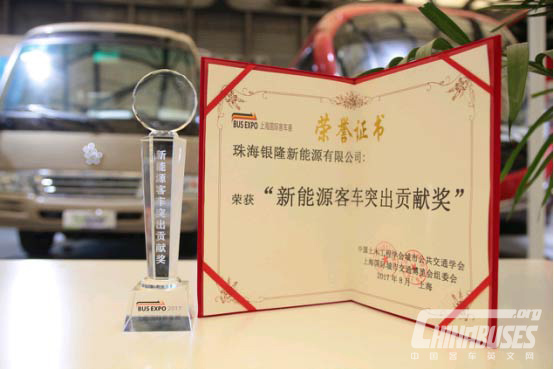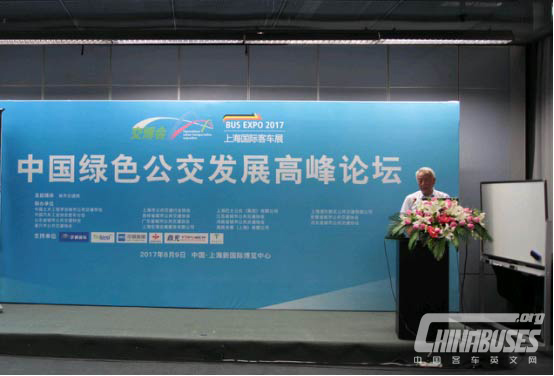From August 9 to 11, Yinlong attended 2017 Shanghai International Bus Exhibition. For its mastery of the first generation of lithium titanate technologies and enormous contributions to green transport, it won Outstanding Contribution to New Energy Bus Industry Award.

At China Green Public Transport Development Summit which was held at the same time, experts from China Civil Engineering Association Urban Public Transport Branch, Shanghai Public Transport Association were invited to deliver keynote speeches on the prospects of new energy bus industry and green public transport.
“We have been conducting investigations and researches in many cities across China. Currently, new energy buses are the fastest growing sector in the new energy vehicle industry. Fast-recharging technologies are the best solution for building green public transport networks”, says Wang Binggang, an expert on new energy vehicle in National 863 Energy Conservation Project.

Wang Binggang, expert on new energy vehicle in National 863 Energy Conservation Project
Currently, China has the largest number of new energy bus demonstration projects in the world, including:
1) Slow-recharging electric bus with long continuous driving distance: the vehicle is the most widely applied in China. With a continuous driving distance of 200-300 kilometers, the vehicle is usually recharged at night. With comparatively higher purchasing costs and lower operation efficiency, the vehicle usually requires large recharging space.
2) Battery-replacement electric bus: with a continuous driving distance of 100 kilometers, the vehicle is major drawback is that it needs big investments for building battery replacement stations. Moreover, its overall operating costs are high as bus operators have to buy extra batteries.
3) Fast-recharging electric bus: the vehicle is usually equipped with high power batteries and is often recharged at bus stations. As its batteries enjoy longer lifespan, the vehicle requires much lower operating costs.
4) Online recharging electric bus: by taking full advantage of the trolley bus facilities, the vehicle is being recharged while in operation. Meanwhile, it can be powered by its power storage system on board. Boasting low operating costs and high operating efficiency if the urban areas have trolley bus facilities available, the vehicle needs large sums of investments if it is to work in cities without trolley bus facilities.
5) Plug-in hybrid city bus: featuring low fuel consumption, the vehicle has not really achieved zero-emission standards. Currently, it has a very visible presence in China.
6) Range-extended electric vehicle and mobile recharging vehicle: both types of vehicles have the smallest presence in China.
For urban bus routes, the one-way distance is usually about 30-40 kilometers. Considering the traffic jams, electric vehicles must reach a continuous driving distance of 70 kilometers. With the fast-recharging technologies available, it only takes about 10 minutes for electric buses to get recharged and then they can travel about 30-40 kilometers. In addition, the vehicle requires lower number of batteries on board, thus it can successfully cut its body weight.
When talking about Yinlong’s fast-recharging technologies, Wang Binggang can hardly contain his admiration, saying “Yinlong’s fast-recharging technologies are the best choice for new energy vehicles, especially city buses”. He also points out that Yinlong lithium titanate batteries enjoy a long lifespan and can sustain the whole life cycle of city buses. In addition, Yinlong lithium titanate batteries have achieved internationally competitive safety standards.
Currently, Yinlong’s fourth generation lithium titanate batteries can be recharged in just six minutes and then power buses on urban roads. Compared with its predecessors, the new batteries have lowered its costs by 40% and improved its energy density by 60%.
At China Green Public Transport Development Summit, Ao Jianhua, Vice President of Yinlong reveals that the company has already mastered hydrogen-titanium power system, which has successfully overcome the energy density problems. In addition, it has further improved the continuous driving distance by taking full advantage of lithium titanate batteries and fuel cells.
Currently, Yinlong electric buses have made their way to a number of cities across China. Thanks to their high reliability and high safety standards, they have won great popularity in China. At 22nd APEC Summit held in Beijing in 2014, Yinlong was designated as the official vehicle for the event. Yinlong sight-seeing tour buses have also been working smoothly at Tian’anmen Square for a few years.